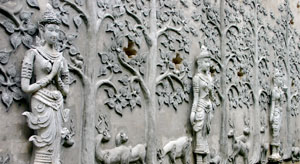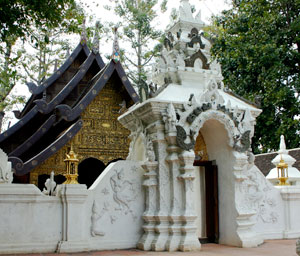AYUTTHAYA, THAILAND – This is one of Thailand’s poorest communities but it’s filled with some of the country’s richest treasures.
“Please mister, buy my carvings,” pleads a young woman at the entrance Wat Mahathat, one of the most revered temples of Thailand’s 30,000-plus.
The poor people of this region rely heavily on tourism to make a living. They stand for hours in the heat and humidity trying to sell their creative carvings and other local crafts to visitors. They’ll even sell you live fish, so you can set them free in a nearby river as your good deed for the day.
That’s how gentle and kind these Thai people are. And that’s especially true in rural communities like Ayutthaya, located about 50 miles north of Bangkok.
“Please, have some cold papaya juice,” offers a woman, who declines my offer of payment. “No, sir, you are our guest and you look very hot.”
The heat is stifling here. Camera lenses get fogged quickly and shirts are drenched in sweat moments after leaving air conditioned cars.
But there is much to see in this town, which once served as Thailand’s capital 400 years ago. Bangkok, by the way, is the third city in the country to hold that honor.
Wat Mahathat was the town’s symbol of power back then. But one night in the early 1700s, invading Burmese warriors stormed the city, burnt the houses and the teak forest that surrounded the sacred temple, which resembles a mini Angkor Wat. The fire became so intense that the red clay buildings of Wat Mahathat began to crumble with the heat. Most of the 400 pagodas that made up the compound were destroyed.
To make matters worse, the invaders later cut off all the heads of all the beautiful statues that lined the temple’s walls as a sign of disrespect. The heads shattered when they hit to stone walkways and the headless images are a reminder of the brutality carried out here.
But not all the heads were destroyed. Remarkably one survived and now amazingly enough is now cradled in the vines of the banyan tree that grew up around it. It’s just one of the fascinating things this part of the world offers tourists.


Above: Some of Thailand's most precious artifacts are gathered in this temple area.
Ironically, Wat Mahathat was built to celebrate a Thai victory over neighboring Burma - now called Myanmar. The Burmese attack of the 1700s was to extract revenge for the earlier Thai attack.
Thailand and Myanmar still squabble on occasion but never engage in battle. Closing the border between the two countries is the most drastic action taken in recent years. Despite their crumpled condition, Wat Mahathat remains impressive.
The main temple, built in the shape of a corncob, was probably designed by Khmer architects, who liked to employ that technique. They also designed Angkor Wat, which accounts for their similarities.
The pagodas surrounding the main temple were meant to serve as community centers, where the locals were taught by revered monks. Small pagodas were built around the main temple by families to show off their wealth. Even today, Thailand’s queen has a country home across the river from Wat Mahathat.
The poor villagers of Ayutthaya are trying desperately to repair the complex – much of the money they collect from tourists goes directly to the rebuilding fund.
One woman sitting at the base of a crumbled temple smiles and shows us the flower arrangements she is selling for less than a dollar. Anywhere else, they would cost 100 times that.
One of the most popular treats offered visitors here is a selection of mouth-watering good watermelons which come in colors of green, red and yellow. All are delicious!
En route to Ayutthaya from Bangkok, about an hour’s drive, visitors get the see Thailand’s rural life and its vast network of farms, where rice paddies glimmer like glass in the noon-day sun. Thailand is actually able to produce three rice crops a year and is one of the top suppliers of the crop to the world.
Another way the locals make money is by selling rides on the backs of their pet elephants. It’s a thrill ride that you won’t soon forget. Most of the country’s 4,000 remaining elephants work in the forests harvesting precious teak trees or are used to entertain tourists. Very few remain in the wild.
Fees for the rides, usually around $5 for 10 minutes, go to a fund set up to help preserve the mighty beasts. Don’t be surprised if some of the local children ask you your name – they like to practice their English.
When we asked one boy his name, he replied: “I’m Happy.”
Most people in Ayutthaya are.
About the Author
Marc Atchison is a veteran journalist and a seasoned traveller with more than 20 years of travel writing experience. As the former Travel Editor of the Toronto Star, Canada's largest newspaper, and now Editor-in-Chief and Senior Writer for TraveLife magazine (Canada) and travelife.ca, Marc has been to over 100 countries in the world. Japan is one of his favorite destinations and he's been there on numerous occasions.